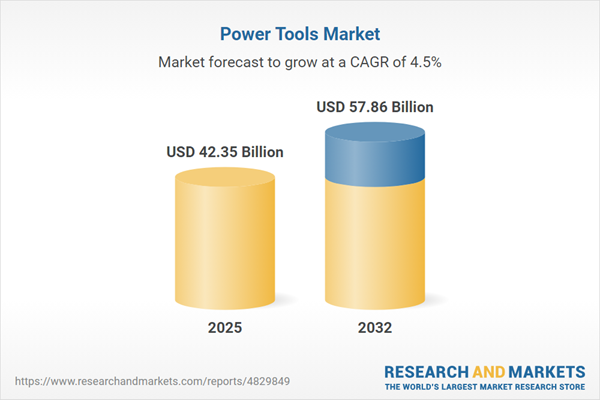Speak directly to the analyst to clarify any post sales queries you may have.
The global power tools market is evolving rapidly, shaped by digital transformation, heightened sustainability demands, and shifting user expectations across industries. Senior decision-makers are prioritizing innovation, efficiency, and resilience as fundamental imperatives for growth and differentiation.
Market Snapshot: Global Power Tools Market Outlook
The Power Tools Market grew from USD 40.58 billion in 2024 to USD 42.35 billion in 2025. It is expected to continue growing at a CAGR of 4.53%, reaching USD 57.86 billion by 2032.
Scope & Segmentation of the Power Tools Market
This market research report provides a comprehensive analysis of core segments and key regions to guide strategic decision-making:
- Product Types: Breaker tools, cutting and sawing tools, drilling tools, fastening tools
- Power Sources: Electric, gas-powered, hydraulic, pneumatic
- Applications: Construction, demolition, metalworking, shipbuilding, woodworking
- Distribution Channels: Offline retail, online retail
- End User Segments: Commercial, industrial, residential
- Regions Covered: Americas, Europe Middle East & Africa, Asia-Pacific
- Key Companies Profiled: Apex Tool Group LLC, Atlas Copco AB, Dynabrade Inc., Emerson Electric Co., Enerpac Tool Group, Fortive Corporation, Hilti Corporation, Husqvarna Group, IDEAL INDUSTRIES INC., Illinois Tool Works Inc., Ingersoll-Rand Inc., Klein Tools Inc., KNIPEX-WERK C. Gustav Putsch KG, Koki Holdings Co. Ltd., Makita Corporation, OLFA Corporation, Panasonic Corporation, Positec Tool Corporation, Robert Bosch GmbH, Sandvik AB, SNA Europe Group, Snap-on Incorporated, Stanley Black & Decker Inc., Taizhou Dingba Power Tools Co. Ltd, Techtronic Industries Company Limited, United Pacific Industries Ltd., Uryu Seisaku Ltd., WUYI CHUANGFENG TOOLS MANUFACTURE CO. LTD., Yamabiko Corporation
Key Takeaways for Senior Decision-Makers
- Digital Ecosystem Integration: IoT-enabled diagnostics, advanced battery management systems, and predictive maintenance are gaining traction as users seek data-driven efficiencies and reduced downtime.
- Focus on Ergonomics and Connectivity: Next-generation portfolios emphasize user comfort, vibration reduction, and wireless controls, enhancing productivity and safety across diverse sectors.
- Sustainability Imperatives: Regulatory and corporate responsibility pressures have led manufacturers to adopt recyclable materials, eco-friendly lubricants, and low-emission technologies across the product lifecycle.
- Segment-Specific Opportunity: Electric solutions dominate in precision-driven environments, while gas, hydraulic, and pneumatic options remain vital for off-grid and heavy industrial tasks. Industries such as construction, shipbuilding, and woodworking are leading adopters of specialized power tools.
- Channel Dynamics: Online retail platforms are gaining share through convenience and transparent pricing, even as offline retail remains important for technical support and live demonstrations in technical applications.
- Regional Growth Drivers: Infrastructure projects, urban renewal, and manufacturing modernization contribute uniquely to demand patterns across Americas, EMEA, and Asia-Pacific markets.
Tariff Impact Across the Power Tools Sector
Recent United States tariffs have introduced supply chain and cost pressures, prompting companies to diversify sourcing and increase local assembly. Strategic pivots include nearshoring, investment in digital procurement, and value-added services like extended warranties and tool management software. These measures collectively support continuity, margin protection, and supplier resilience in the face of persistent policy uncertainty.
Methodology & Data Sources
Primary research included executive interviews and field visits, while secondary sources ranged from trade publications and regulatory filings to industry databases. Quantitative and qualitative data were integrated and validated through multi-variant models and expert reviews, ensuring high reliability and analytical precision throughout the report.
Why This Power Tools Market Report Matters
- Equips executives with actionable intelligence for market entry, portfolio diversification, and competitive positioning in dynamic environments.
- Highlights emerging technologies and business models that inform capital allocation and partnership strategies for manufacturers and distributors.
- Delivers a robust industry benchmark supporting forward-looking decision-making under volatile regulatory and economic scenarios.
Conclusion
Senior leaders can leverage this research to identify resilient growth pathways by adopting digital innovation, prioritizing sustainability, and building agile value chains. The insights provided help inform strategies that align with evolving market and regulatory realities.
Additional Product Information:
- Purchase of this report includes 1 year online access with quarterly updates.
- This report can be updated on request. Please contact our Customer Experience team using the Ask a Question widget on our website.
Table of Contents
3. Executive Summary
4. Market Overview
7. Cumulative Impact of Artificial Intelligence 2025
Companies Mentioned
The companies profiled in this Power Tools market report include:- Apex Tool Group, LLC
- Atlas Copco AB
- Dynabrade, Inc.
- Emerson Electric Co.
- Enerpac Tool Group
- Fortive Corporation
- Hilti Corporation
- Husqvarna Group
- IDEAL INDUSTRIES, INC.
- Illinois Tool Works Inc.
- Ingersoll-Rand Inc.
- Klein Tools, Inc
- KNIPEX-WERK C. Gustav Putsch KG
- Koki Holdings Co., Ltd.
- Makita Corporation
- OLFA Corporation
- Panasonic Corporation
- Positec Tool Corporation
- Robert Bosch GmbH
- Sandvik AB
- SNA Europe Group
- Snap-on Incorporated
- Stanley Black & Decker, Inc.
- Taizhou Dingba Power Tools Co., Ltd
- Techtronic Industries Company Limited
- United Pacific Industries Ltd.
- Uryu Seisaku, Ltd.
- WUYI CHUANGFENG TOOLS MANUFACTURE CO., LTD.
- Yamabiko Corporation
Table Information
| Report Attribute | Details |
|---|---|
| No. of Pages | 186 |
| Published | November 2025 |
| Forecast Period | 2025 - 2032 |
| Estimated Market Value ( USD | $ 42.35 Billion |
| Forecasted Market Value ( USD | $ 57.86 Billion |
| Compound Annual Growth Rate | 4.5% |
| Regions Covered | Global |
| No. of Companies Mentioned | 30 |









